- Sail Loot Podcast 063: Sailing With FIRE on Luna Sea with Mark and Jennifer
- Sail Loot Podcast 062: Andersons Abroad own Sea-Tech Systems to make Sailing Money
- Sail Loot Podcast 048: Neil Davies Sails to Cuba and Works Remotely for Sailing Money
- Sail Loot Podcast 042: Wiley Sharp, Part 2 – Owning and Operating a Virgin Islands Sailing Charter
- Sail Loot Podcast 037: Salty Times Sailing to find the Surf with Base and Jamie
- Sail Loot Podcast 027: Couchsailors Jose and Gina Rent All of their Rooms for Sailing Money
- Sail Loot Podcast 020: Leah Kruger Makes Her Sailing Money With Brio
- Sail Loot Podcast 019: Good Anchorage, Get Paid To Cruise
- Sail Loot Podcast 013: Investing Money to Make Money While Sailing the Mediterranean with Franz Amussen
- Sail Loot Podcast 012: From Corporate America to Ottsworld with Sherry Ott
Basic Cruising Course: The 2nd Step to Improving Sailing Skills – Day 1
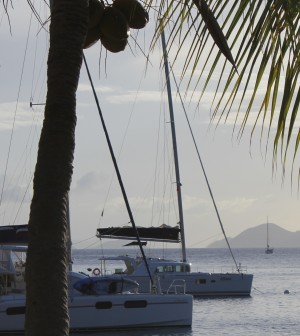
We learned some new sailing skills in our Basic Keelboat course and it was time to put those skills into action on a bigger sailboat. We also had some things to learn about cruising and living on a sailboat.
Our sailing vessel for the rest of the week would be a Lagoon 440 catamaran named Allison that Rob Swain Sailing School had chartered from TMM Yacht Charters for us.
The first of our new sailing lessons began at 10am on July 14, 2014. These lessons included tips essential for cruising on a chartered sailboat such as packing, loading, and storing gear on the sailing vessel, as well as provisioning, and going over all of the pre-departure forms, contracts, and checklists.
Packing, Loading, and Gear Storage
Packing and gear storage was pretty easy for my wife, Megan and I. We had been on 10 day sailing trips before and knew to try to pack light, and use soft-sided luggage or duffel bags that can be folded up and stuffed away in a locker when emptied.
The funny thing is that it never looks as if we take this packing light tip seriously because we always bring all of our own SCUBA and snorkel equipment. However, we made sure to purchase light weight Buoyancy Control Devices (BCD), and we can’t really travel with tanks and weights. Therefore, all of our SCUBA equipment, for BOTH of us, fits into one light weight, soft-sided piece of luggage that weighs less than 50 lbs and can be checked on any flight.
It’s also easy enough to store our SCUBA equipment on the boat. We basically just used one nacelle for everybody’s snorkel and SCUBA gear. Everybody is going to want to have some snorkel gear no matter what, and the only thing that is added for a SCUBA setup is a BCD, regulator, and weights. Our sailing instructor, Rory, even brought his SCUBA gear. We rented some tanks, and a rack to keep them securely on the sailboat from the local dive shop.
We only had one other bag for our clothes, and a “personal item” each. The bag with our clothes was a backpacking bag, my wife had a large purse as her personal item, and my personal item was a backpack filled with electronics.
The British Virgin Islands are so beautiful both above water and below that I just can’t miss an opportunity to capture it on my Cannon 60D DSLR or my GoPro Hero 3. Of course, when traveling with these items it is necessary to have at least 1 or 2 lens choices, some extra batteries, battery chargers, tripods, and mounts. Throw a laptop, our passports, and travel documentation in and my personal item was full.
Even with all of our SCUBA gear and camera equipment, everything fit into all of the lockers in our berth, or the nacelles without any trouble. We were all quite comfortable on Allison.
Provisioning
Provisioning was also made quite easy by Rob Swain Sailing School and TMM Yacht Charters. In fact, it seems as if provisioning in Tortola is really simple. As Rory stated several times, “The BVI is The Disney World of Sailing” and everything is done so that people chartering sailboats on vacation can sit back, relax, and enjoy their sailing adventure.
We had already filled out a provisioning menu with Rob Swain Sailing School. They were taking care of ordering the food from a grocery store on Tortola and getting all of the food delivered from the grocery store directly to our yacht, Allison! The provisioning menu included:
Provisioning Menu:
- Starter Kit – Liquid dish soap, aluminum foil, garbage bags, bathroom tissue, paper towels, napkins, trash bags, handiwipes, scouring pad, ziplock bags, charcoal, and matches.
- Condiments – Pickles, olive oil, vinegar, mayonnaise, bbq sauce, butter, mustard, garlic, jam, peanut butter, and a spice kit.
- Breakfast Items – Bananas, Apples, Oranges, Bacon, Eggs, Yogurt (assorted flavors), English Muffins, Assorted Cereals w/milk, Tea and Coffee, and Orange Juice
- Lunch Items – note: we chose a lot of these ourselves – Turkey, Ham, Roast Beef, Cheddar Cheese, Gouda, Swiss Cheese, Wheat Bread, lettuce, tomato.
- Snacks – Hummus, Carrots, Tortilla Chips, Salsa, Pretzels, Chips, Peanuts, Cheese and Crackers
- Dinners – note: 3 dinners on board, 2 dinners at restaurants, and we chose most of these items as well – Steak with potato, chicken with pasta, fish with rice.
We were pretty well taken care of as far as provisions go! The only thing that we had to get ourselves was all of our liquids and anything specific that wasn’t mentioned in the menu. We went to the grocery store that was right up the street and picked up several gallons of drinking water, lots of beer, some rum, some cookies and things for desert, and some fresh fruits. The mangos were in season. I think we bought every mango that they had in the store!
Pre-Departure Checklists
Prior to releasing the dock lines and setting sail a representative from the charter company should always get on board, give you a tour, show you all of the safety equipment, show you the bilge(s) and bilge pumps, explain the use of the heads, explain the electronics, and go over all of the necessary documentation with you.
If I recall correctly, the representative we met with was named Sam. He was a witty English fellow and was always cracking a joke! He warned us of some jellyfish, especially the sea wasp or box jellyfish, and told us to report any Lion-fish sightings. He went over all of the paperwork, showed us the boat manual, explained not to put anything down the head that has not been eaten, showed us both bilges, both engines, and explained all of the electronics. He also showed us how to use the electric windlass, and pointed out the emergency tiller (“not that we’ll ever need it,” he said).
After he went over these few things it was time to go over the pre-departure checklist on our own. It was our job to mark down how many life jackets, flotation devices, flashlights, pliers, screwdrivers, fenders, dock lines, boat hooks, noodles, snorkel gear, and emergency tillers we were leaving the dock with. We went through every item on the checklist and made sure we saw it with or own eyes and knew where it was. The emergency tiller had already been pointed out to us, so of course, we marked that we had one of those on board.
By the time we finished stowing all of our gear, getting the provisions on board, shopping for all of our liquids and extra fruits and deserts, getting ice situated, and filling out all of our pre-departure paperwork it was early afternoon and time for lunch.
It was already later in the day than we wanted it to be so we decided to grab some lunch at the Royal BVI Yacht Club. It was right next door and we could do our chart briefing while we ate. Our first destination was Manchioneel Bay in Cooper Island. We could see it out in the distance of the beautiful view that we had at the Royal BVI Yacht Club. It looked like the bay was filling up with sailboats, but we hoped that there were one or two mooring balls left so that we could pick one up when we got there.
Rory had decided that I was the captain for the afternoon. We would rotate throughout the week, but this meant that I would be at the helm for most of our sail to Cooper Island and that I would be driving us onto the mooring ball in Manchioneel Bay.
Setting Sail
We were done with lunch, and it was finally time to set sail. We boarded Allison and did one more quick check to make sure that we weren’t forgetting anything on the dock. I was captain so it was my job to do the C.O.B.B check prior to departing. This meant that I had to check the Coolant, Oil, Belts, and Bilges.
All was well, and it was time to release our docking lines. Even though I was captain for the day Rory was at the helm in order to get us out of the marina and out of Road Harbour. After all, nobody else on board had ever driven a 44 foot yacht before.
As soon as we were in an area where we had enough room to maneuver, I took the helm and it was time to head up into the wind in order to raise the main sail.
Allison was set up perfectly for teaching a sailing class. Her cockpit was up on top of the galley and was a long bench across almost the entire beam of the catamaran. There was probably enough room to seat 8 people up there. For four students and and instructor there was plenty of room.
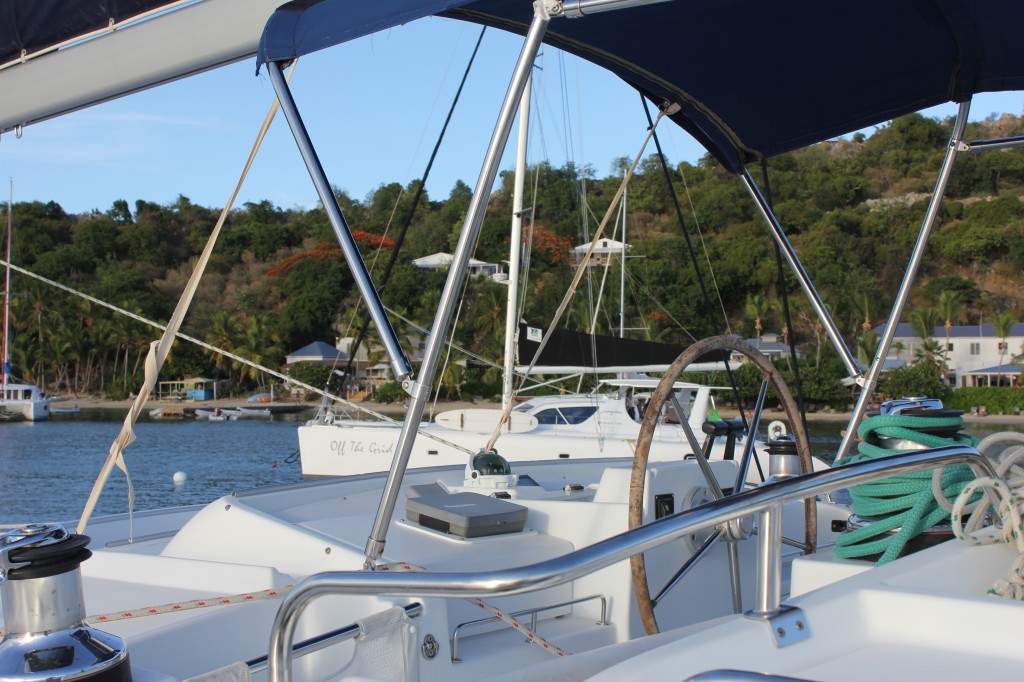
Allison’s Cockpit
Allison was rigged so that we could have one person on the port jib sheet, one person on the starboard jib sheet, one person on the main sheet and one person on the helm. Rory would help when needed, and would always explain what he was doing and why he was doing it. For example, there were times when he may have helped keep a little tension on the furling line.
The sail to Cooper Island was awesome! Once we got the main sail up and unfurled the jib, we were close hauled on a port tack most of the way and it was my job to get a feel for steering Allison and keeping her in the groove by using the jib’s telltales.
We also practiced our first few tacks with a 44 foot catamaran. We had gotten to the point where we were tacking with ease on the IC24. Tacking Allison was essentially the same general procedure, but we just had to perform the maneuver on a boat that was 20 feet longer, much wider, had 2 hulls, and was rigged differently.
Once we all got comfortable tacking Allison from our positions, it was time to switch it up a little bit. Fred took the helm, and I moved to a jib sheet for a little while. We went through the procedure of getting used to the feel of steering the sailboat and getting into the groove from our new positions. We performed a few more tacks until it was time to pull into Manchioneel Bay and find a mooring ball.
I re-took the helm as the acting Captain for the afternoon and we went through the procedures of furling the jib. I then started the engines and headed up into the wind so that we could lower the main sail.
It was time to pick up a mooring ball. Luckily, there were still a few left. As always, Rory assigned crew positions. I was at the helm, Fred would be picking up the mooring pennant with the boat hook and leading the bow lines through the eye of the pennant, Cindy was directing me onto the mooring ball with hand signals, and Megan was looking beautiful (as always!) and helping if necessary.
Rory picked a ball and we were headed in. I had the throttles just above neutral for both engines so that I could still maintain steerage with the wheel. Once we got closer I mainly used both engines to steer the boat.
Our line onto the mooring ball was very good, but we ended up going too fast and over-shooting the mooring ball by just a little bit. Fred had the pennant in the boat hook, but ended up dropping it because we were gliding over the ball (Cindy should have told me to stop earlier! ;). I put both engines into reverse to stop us from gliding forward, and kept them in reverse for just a second to move us back a bit. The ball showed up off the bow of the boat again and Fred was able to safely pick up the pennant and attach the bow lines through the eye.
We had just picked up our first mooring ball. Our first sail was successful!
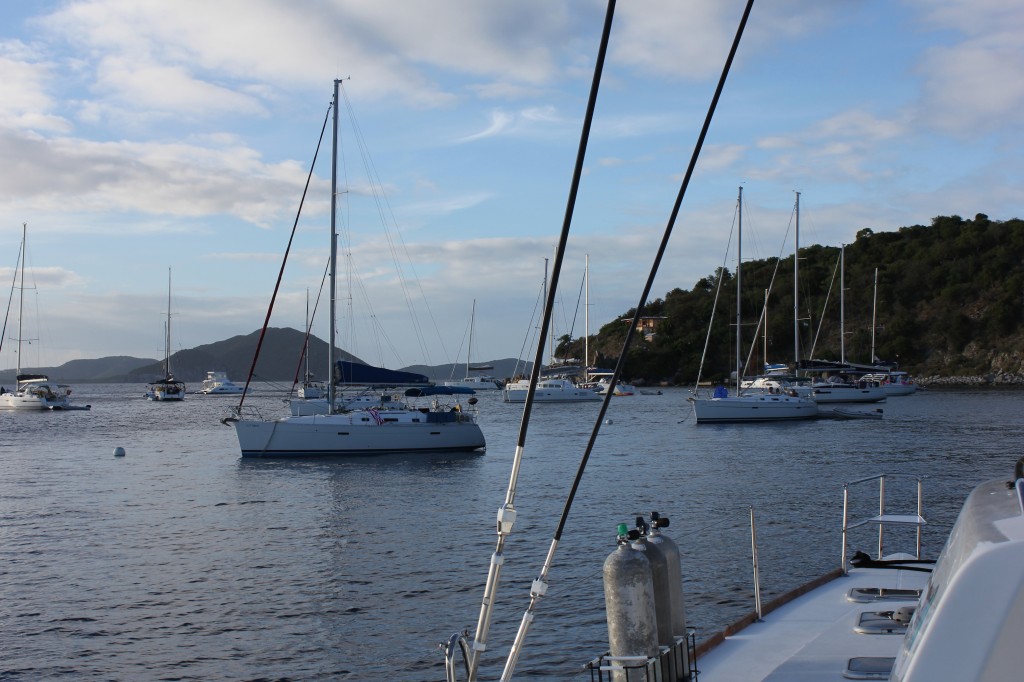
Manchioneel Bay Moorings from Allison’s Port Quarter
It was time to start the generator, turn on the air conditioning, crack open a beer, and have a short post-sail lesson from Rory. We mostly went over communications and VHF channels. We quickly found out that our VHF radio wasn’t working when we tried to use it to make reservations for dinner at the Cooper Island Beach Club.
No problem! The lesson was complete, and with the BVI being “The Disneyland of Sailing” we used a cell phone to make our dinner reservations.
I highly recommend trying the Cooper Island Beach club for dinner if you’re ever in the neighborhood. I had the mussels in curry sauce and they were fantastic. They also have an underwater video camera at the end of their dock. The live feed from the camera is on a large screen behind their bar.
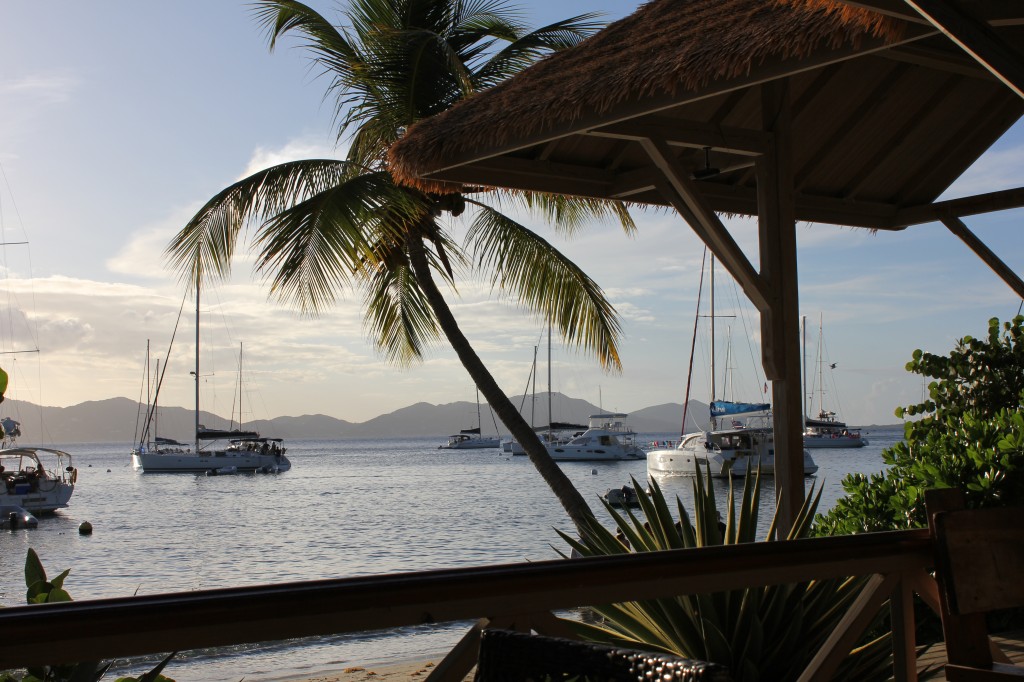
Our view for dinner from Cooper Island Beach Club
Just a few steps away on the boardwalk or the beach is a small rum bar with an extraordinary selection of rum from cheap to not so cheap. Megan and I decided to get a tasting flight of four different rums. The bartender was very knowledgeable and explained every single one to us. Our favorite was actually a Guatemalan rum, the Ron Zacapa Centenario 23.
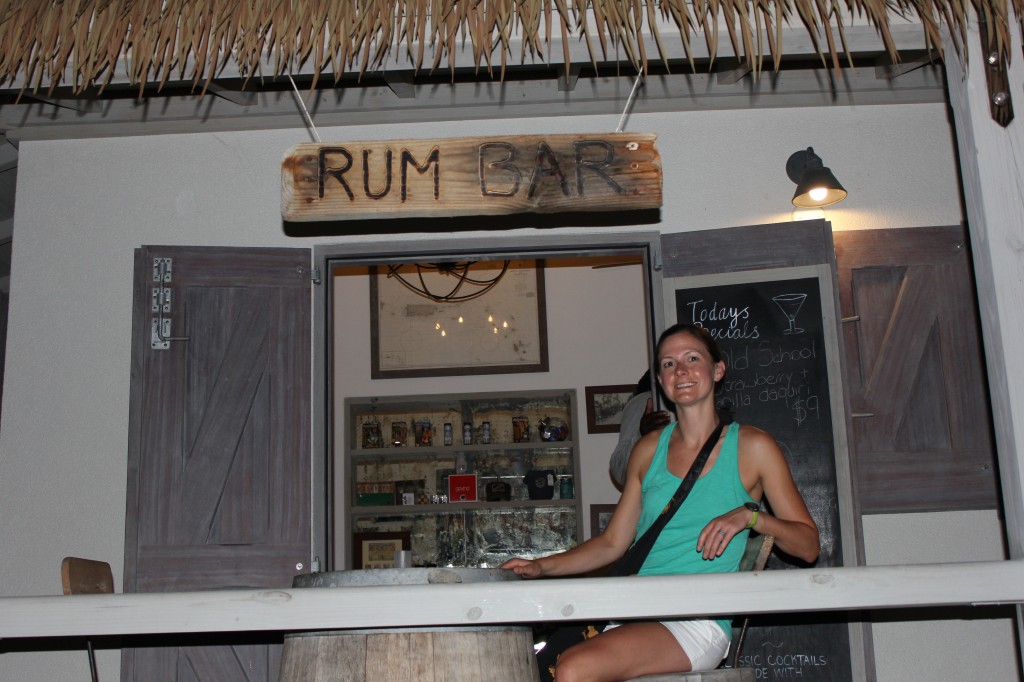
Megan at the Entrance of the Rum Bar at Cooper Island Beach Club
Our first day of Basic Cruising was in the books, and it was time to find our dinghy and head back to Allison so that we could get some sleep. We had to wake up early the next morning to get over to the Rhone!
We hope you’re enjoying our stories of our sailing adventures so far. If you’d like to find out what happened with our emergency tiller, keep checking back and check out our blog post about day 1 of our Bareboat Cruising course.
Until then, we’d love to hear some of your stories. Leave us a note over at Facebook or Twitter. We’d love to chat!
TeddyJ


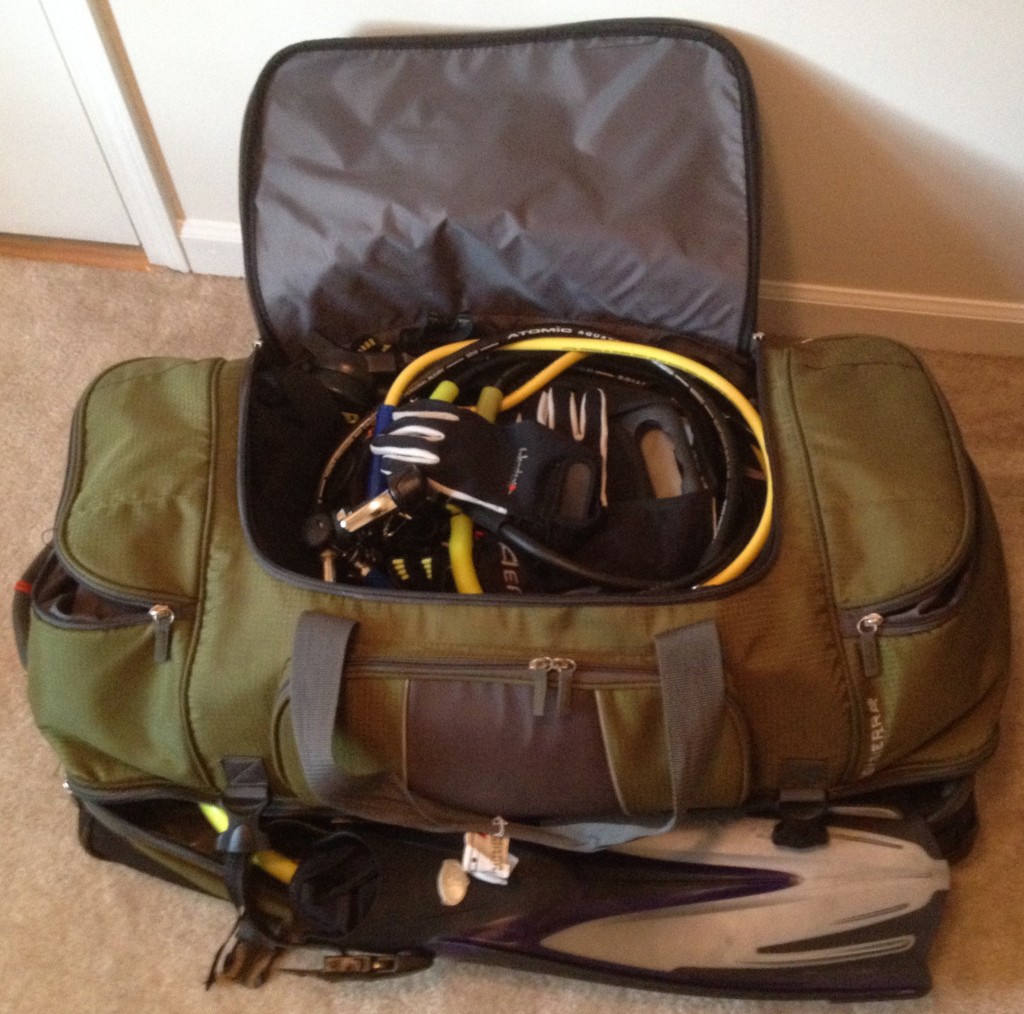
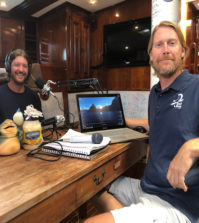
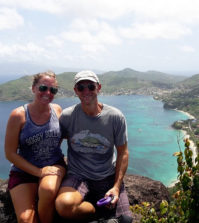
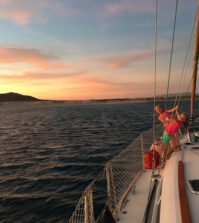
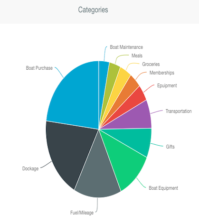
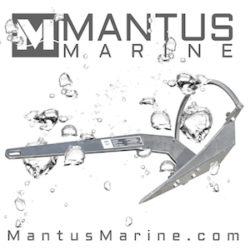

Pingback: Sail Loot Bareboat Cruising Course: The Third Step To Improving Our Sailing Skills – Day 1 (Day 4 Aboard Allison) | Sail Loot